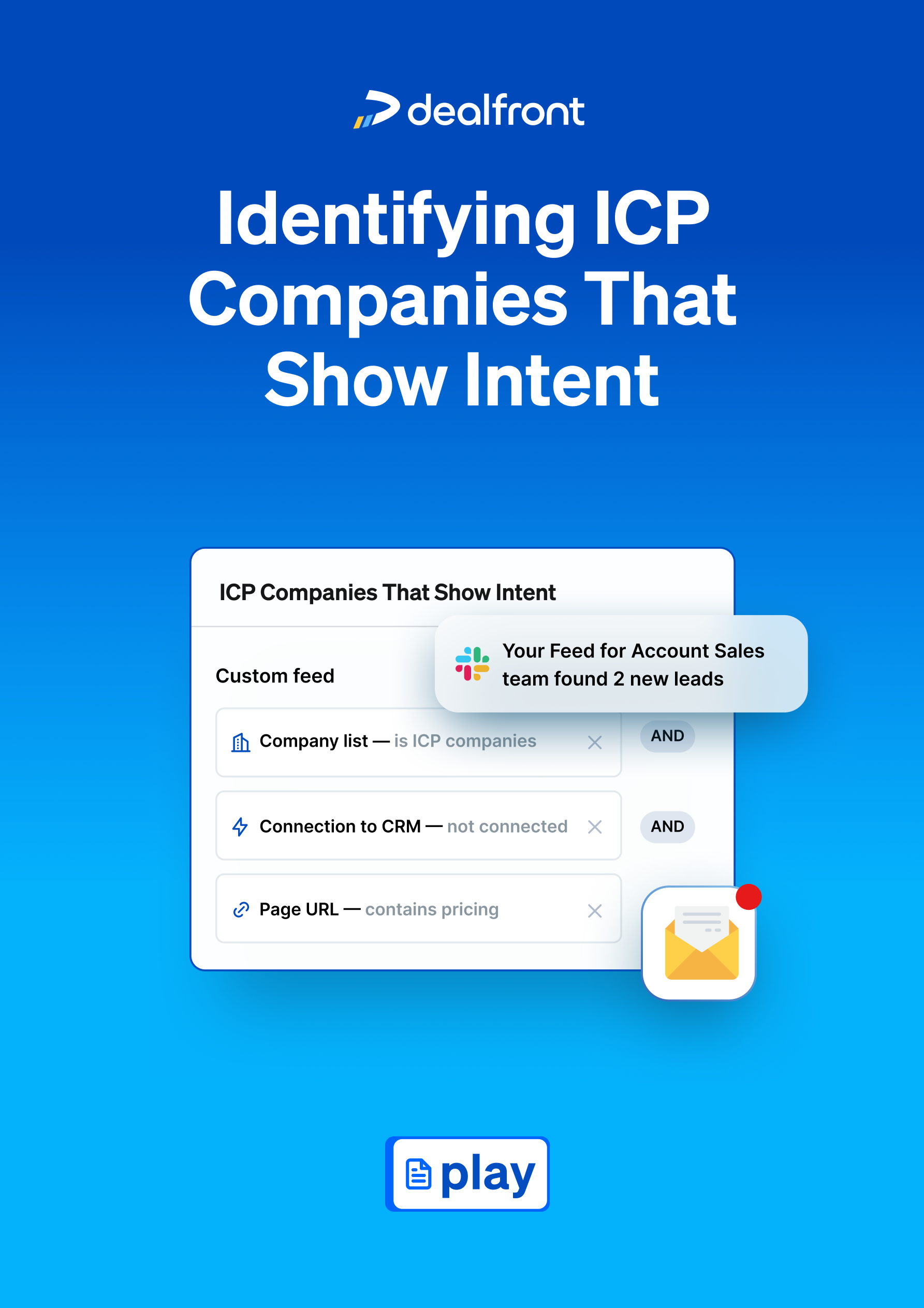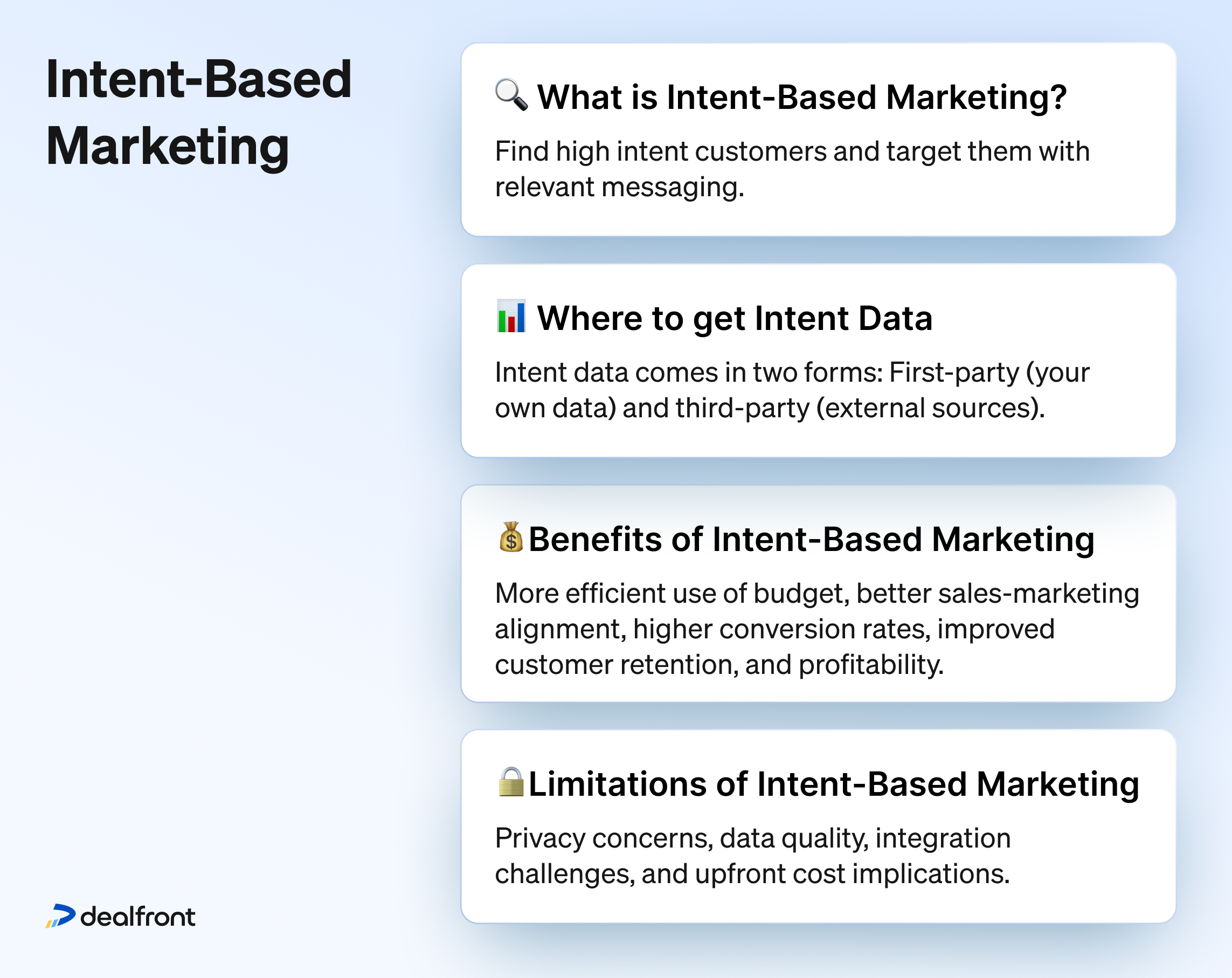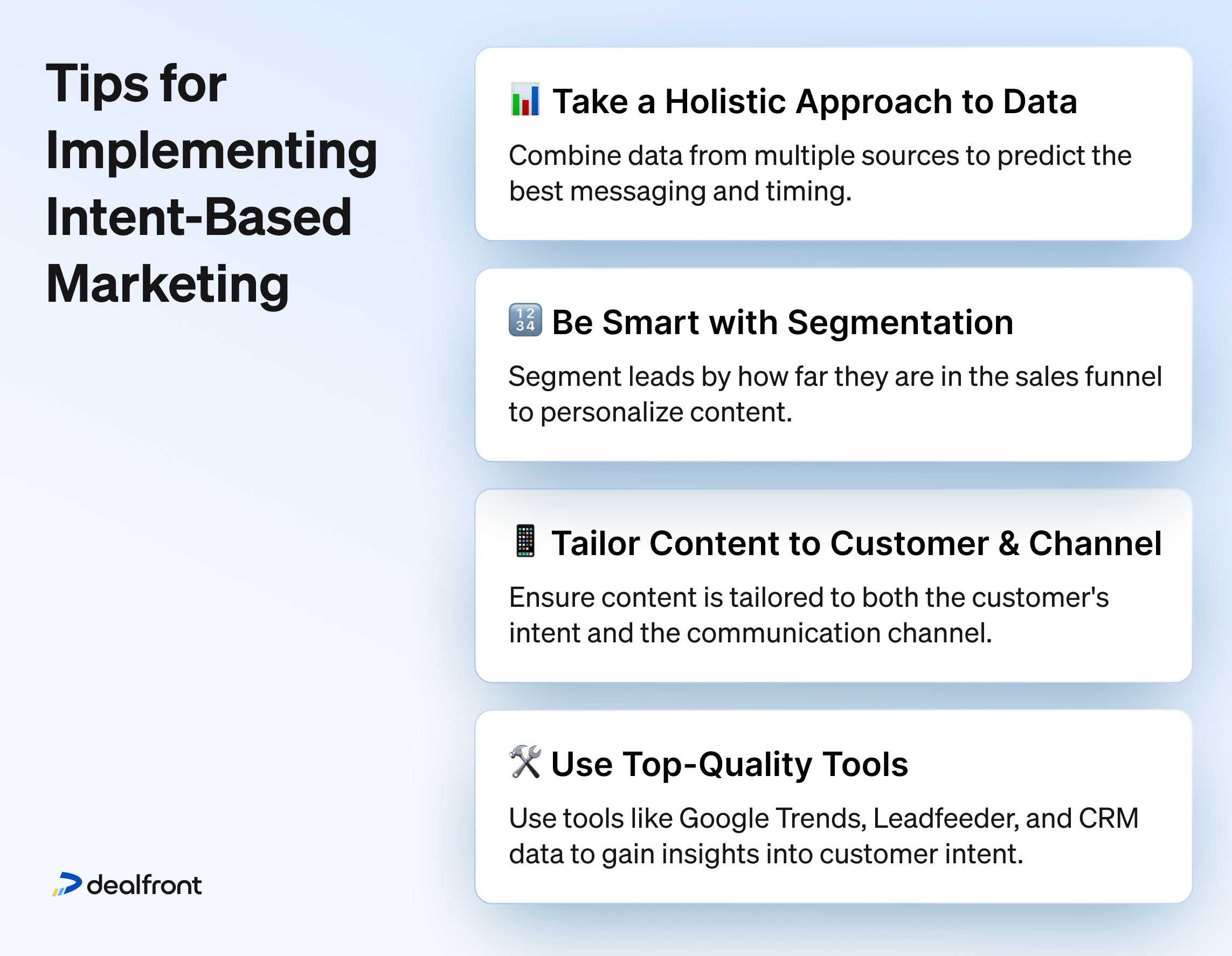Just imagine it for a second. Wouldn’t it be terrific to be able to cut through all the noise and easily find people who are enthusiastic about your product? Even before you’ve actually reached out to them directly.
Enter intent-based marketing.
If you’re not familiar with the concept, get ready for a revelation. And if you’ve heard of it before but aren’t clear on the details, you’re in the right place.
Let’s explore what intent-based marketing is and how it works. We’ll also take a look at the reasons it’s important, as well as give you a few tips for how to execute it well.
What is intent-based marketing?
Intent-based marketing is all about finding potential customers who have a high degree of buying intent, and targeting them with relevant messaging.
In traditional marketing, before online analytics were widely available, this was notoriously difficult to achieve.
Sure, you could segment a TV channel’s audiences or a newspaper’s readership according to their demographic profiles and advertise accordingly. But it was essentially a scattergun approach that could only ever yield approximate results. As the merchant John Wanamaker is famously reported to have said:
“Half the money I spend on advertising is wasted; the trouble is I don’t know which half.”
Luckily, we’ve come a long way since then.
Thanks to the availability of granular data about user behavior online, it’s now possible to build up quite detailed profiles of potential clients. You can use intent-based marketing tools to uncover crucial buyer intent signals and target the right prospects at the right time.
But where exactly does this data come from?
Where to get intent data
The first thing to bear in mind is that you can divide intent data into two categories: First-party and third-party data.
First-party data is the data you collect via your own resources. For instance, data about users browsing your company website. Third-party data is data that comes from other sources.
Both can be valuable, but first-party data is obviously easier to come by since it comes from in-house sources. That’s not to say that third-party data is difficult to get your hands on, though—not at all. If you know where to look and what tools to use, it’s simplicity itself.
Beyond this distinction, we can further break down intent data by type.
Here are the four main types of B2B intent data and how you can access them:
Engagement data: Tells you how far users are engaging with a particular piece of content. This could mean posting comments on social media brand pages, reading or sharing blog posts, or opening marketing emails.
Depending on where the content is hosted, you gather this type of data either using social media analytics solutions or tools like Dealfront’s solutions that help you monitor user behavior on your website in real time.
Search data: One of the best ways of getting insight into a potential buyer’s intent is to track what they type into a search engine using tools like Google Search Console. You can then tailor your messaging accordingly.
For example, a user who searches for “best email marketing tools” is showing more buying intent than one who searches for “what is email marketing?”. If your company sells email marketing solutions, you’d target the former as a priority.
Firmographic data: Information about companies such as their location, size, and industry niche. Strictly speaking, this isn’t about primary intent, but it provides useful context. And it’s indispensable in helping you find the right contacts to reach out to.
You can get this data from business directories or B2B data providers like Dealfront.
Technographic data: This is information about a potential client’s tech infrastructure. It includes any hardware it has, software it uses, and networks it’s connected to.
This is particularly relevant if you sell B2B software because it gives you a good idea which companies might be ready to implement your solution. Generally speaking, you’ll need to rely on research from surveys or questionnaires to find this.
The importance of intent-based marketing: Benefits for your sales and marketing teams
So, why is intent-based marketing so important? And what are the real-world advantages it offers to your sales and marketing teams?
Here, we run down a few of the most important benefits of B2B intent-based marketing:
1. More efficient use of budget
Few companies enjoy the luxury of an unlimited advertising budget. Allocating your marketing resources effectively means making choices, and the more information you have to base those choices on, the better.
The great thing about intent-based marketing is that you’re actively seeking out the people who are most likely to buy your product. More to the point, you’re aiming to catch them at the exact moment they’re getting ready to make a commitment to purchase.
With robust intent data in your pocket, you can focus your efforts on those individuals showing the most promise of converting. This means you’re not wasting time and money reaching out to non-starters. As a result, you make the most efficient use possible of your available budget.
2. Better alignment between sales and marketing teams
Your sales agents work at their best when they get the kind of support they need from the marketing team. That means making sure everyone is on the same page is crucial to success.
When everyone involved has an in-depth understanding of customer needs, it helps keep the sales wheels turning smoothly. Using intent-based lead scoring establishes a firm foundation upon which to base your sales strategy.
It enables your sales agents to reach out to prospects with confidence, too.
That’s because they know those prospects have been carefully chosen on the basis of solid intent data. They won’t need to waste their time and energy on cold leads that go nowhere. Instead, they’ll be following up on hot leads who are ready to commit.
3. Higher conversion rates
When your sales agents work their magic, you’ll see the results in terms of higher conversion rates. When you research leads using intent as a measure, you’re able to personalize your messaging effectively to each individual.
For your intended customers, the experience is a seamless one. As far as they’re concerned, they’re receiving marketing messages they’re actively interested in, rather than having to delete irrelevant emails or fend off unwanted sales approaches.
The result?
You’ve reached the right person just as they’re getting ready to buy, so your conversion rates will show a healthy and sustainable increase.
4. Improved customer retention rates
One aspect of intent-based marketing that’s often overlooked is that it doesn’t just boost new customer conversions; it can also help you retain the customers you already have.
Since you have a good understanding of customer intent, you can create more engaging experiences to keep them on board. You can also develop specially tailored offers to retain their interest.
In addition, you can deploy techniques like predictive analytics to pinpoint which customers are most likely to churn at any given moment, taking a cue from their behavior. This means you can reach out quickly to try to re-engage them before they switch to a competitor.
5. Boosts profitability
Overall, these benefits add up to great news for the bottom line. You’ll convert more prospects, make the most efficient use of your marketing budget, and retain your existing customers more effectively.
As a result, you don’t need to spend as much on marketing or customer acquisition, both of which constitute significant cost sinks for most businesses.
And, of course, the fact your sales and marketing teams are able to collaborate much more effectively means they’ll feel happier in their roles because they’ll see their work paying dividends. When your employees feel supported and valued, they’re more likely to stick around, leading to lower recruitment costs over the long term as well.
Possible intent-based marketing limitations
Although there are many great benefits to intent-based marketing, as with anything else, there are a few limitations as well.
They’re not deal-breakers, but it’s best to be aware of them so you can make sure you don’t fall into any traps. Here’s a quick overview:
Privacy concerns: Some users are hyper-vigilant about the privacy of their personal data. While companies will generally do all they can to assuage any privacy-related fears—not least because they need to remain compliant with legislation like GDPR and HIPAA—the precautions taken won’t be enough for some.
The main impact this has is relatively marginal, though. It just means some types of data might be more difficult to come by, so you’ll need to make the best use of what you have.
Data quality: Garbage in, garbage out, as they say. If the quality of your data isn’t top-notch, you might not be able to read intent signals accurately enough for them to be useful.
To prevent this, ensure you’re collecting accurate data about the right topics and activities.
Data integration: This can become an issue if you face difficulties integrating intent data with your existing tech stack, and the more data sources you’re pulling from, the more complex the challenge becomes.
Luckily, this limitation is fairly straightforward to overcome; you simply need to do your research to make sure the tools you use are a good fit for your needs.
Cost implications: Initially, switching to intent-based marketing can involve a significant upfront investment in new technology and overhauling existing processes.
While this does involve an increase in costs in the short term, bear in mind that once your new system is working effectively, it will help you reduce costs over the long term.
Intent-based marketing examples
So, what does all this look like in practice?
From what we’ve talked about so far, it’s evident that there are a number of ways you can use intent-based data to target potential customers.
Here are a few examples of how you might do that:
1. Personalizing content
Let’s say you run a company that specializes in project management software. You monitor how users behave on your website, and as a result, obtain some useful web visitor intent data that you can use to personalize the content you produce.
You can tell which visitors are closer to making a purchase by monitoring which pages they visit. For instance, those who linger on product and pricing pages and sign up to your email list are much more likely to buy soon than users who are just browsing your blog content.
Now, suppose you take the list of visitors who signed up to your emails and compare it to your sales intelligence data.
Let’s just take one criterion to keep it simple: Company size. You could split the list into visitors from larger enterprises and smaller companies. Then, you create different emails to send to each.
The email targeting the larger enterprises could highlight how your project management software helps teams collaborate effectively internationally. Whereas, for the smaller company, you might send an email that includes a couple of case studies of smaller businesses that have thrived using your software.
That’s just one simple example of using intent-data to generate pipeline. Depending on your business needs and goals, there are any number of avenues to explore.
2. Targeted ads
A particularly useful intent-based marketing technique is to monitor the online activities of users who click on ads.
You can use tools like Google Analytics to analyze ad performance data and connect it with user data such as location and demographic profiles.
This allows you to create different versions of ads to appeal to a variety of potential customers and target them effectively at a granular level. For instance, creating display ads specifically for your ICPs.
It also leaves room for experimentation. You can try A/B testing different ads to see how they perform with different categories of users. Over time, this helps you fine-tune your ad creation process because it gives you a much better idea which ads hit well with each group.
[https://www.youtube.com/watch?v=A68kOZNe3ms&t=1s]
The basic goal is to adapt your ad messaging to each user’s individual preferences so that they’re more likely to notice it.
Studying user intent can also help you understand when to target specific groups, which can boost clickthrough rates substantially.
3. Social media campaigns
One of the great things about modern social media platforms from a marketer’s point of view is that they’re essentially built for granular-level targeting. This makes them an ideal foundation for intent-based marketing.
Pretty much every time anyone interacts in some way on a social media site, they’re revealing huge amounts of information about their likes and preferences. You can learn a lot simply by listening in.
"Social media campaigns empower B2B marketers to reach the right decision-makers with laser-focused targeting—turning engagement into qualified leads and brand awareness into measurable business growth."
Patrick Schüller, Paid Social Manager at Leadfeeder
When you’ve built up a good database of intent-based data, you can put it to work for you on social platforms. You can do this in a number of ways:
Social listening: Establish social-focused intent-based data by monitoring industry conversations and hashtags relevant to your brand.
Engage directly: Interact with potential customers by commenting, answering questions, or sharing links to your content.
Dynamic retargeting: Target groups of users with tailored content depending on their social media activity.
Tips for implementing intent-based marketing
It’s time to take stock and finish up with a few important points to bear in mind when you’re implementing intent-based marketing.
It’s a wide-ranging subject, but if you remember a few core principles, you won’t go far wrong. Here’s our handy list of top tips:
Take a holistic approach to data
Let’s face it, your company deals with a huge amount of data every day, and sifting through it can be a challenge.
The crucial point to bear in mind is that the goal is to combine relevant data from multiple sources to build up the most accurate picture possible of each potential customer.
This is what we mean by a holistic approach to data. The aim is to unearth patterns in the information available that can help you predict which messaging will land best with different users. And, in addition, whether there are any trigger moments where those users will be most receptive.
Start with your first-party data. Leverage the customer data you already have from your website analytics, CRM platform, social media accounts, and other research to build up profiles of your target clients.
Then, add third-party data on top. Look at keyword search data, third-party review sites, or even industry-relevant news articles to build up a more nuanced picture of customer intent.
Be smart with segmentation
When you’re looking for viable business leads, one of the most powerful techniques in your toolkit is segmentation.
Now, there are many ways of segmenting a target audience, but it’s vital to define the segments in accordance with your goals. In this case, we’re focusing on intent, so you should assign leads accordingly.
For example, you might decide to assign them to categories depending on how far down the sales funnel they are.
Potential customers who have only just learned your company exists might respond positively to blog content that builds your authority in their eyes. Whereas a hot lead who is close to making a purchase commitment would probably appreciate an offer of a product demo.
Tailor content both to the customer and the channel
In fact, that’s one example of the golden rule: Create exquisitely tailored content.
The world is awash with content, and not all of it is as engaging as it could be. It’s your job to make sure you deliver content that’s interesting, highly relevant, and encourages prospects to engage with your brand further.
Bear in mind that even if you tailor your content according to customer intent, it will be less effective if you don’t make it suitable for the channel you use to share it as well.
Let’s say you’re planning a social campaign to advertise your company’s data management solution. This will work best if you match your content to the medium.
For instance, Instagram is a highly visual and fast-paced medium, so it might not be the best choice for a technical explainer; a simple how-to YouTube video would get more engagement.
On the other hand, imagine you’re hosting a data management industry conference in a scenic location to drum up business. In that case, posting a well-designed invitation featuring an eye-catching photo of the venue on Instagram could help you achieve more reach.
Get top-quality tools on your side
Finally, a few well-chosen tools can make all the difference when you’re trying to leverage the benefits of intent-based marketing.
Tools like Google Trends, Ahrefs, and Answerthepublic will help you nail down the details of what keywords and topics your target customers are searching for.
Meanwhile, combining your own website analytics with your CRM data will allow you to uncover crucial behavioral patterns.
Tools like Leadfeeder by Dealfront, what’s more, can then help you generate critical intent-based insights and capitalize on them.
In short, there’s no need to feel overwhelmed by data. There are plenty of smart software solutions available to guide you, so be sure to make the most of them.
Leverage intent-based marketing to connect with your most valuable leads
Being consistent in finding high-value leads is fundamental to success in B2B marketing. And the best way of maximizing conversion rates is to approach the right people at the right time with the right message.
That’s what makes intent-based marketing so powerful. When you truly understand what your target audience’s intent, needs, and preferences are, you can create content that really resonates with them and piques their interest.
What’s more, when you focus on high-intent users, you don’t waste time chasing cold leads that were never going to be a good fit for your product. Instead, you make the most efficient use possible of your marketing resources, boosting your ROI in the process.
It’s a data-driven world out there, so make the most of it. Now’s the time to start leveraging intent-based marketing techniques to connect with valuable leads—and turn them into loyal customers.




